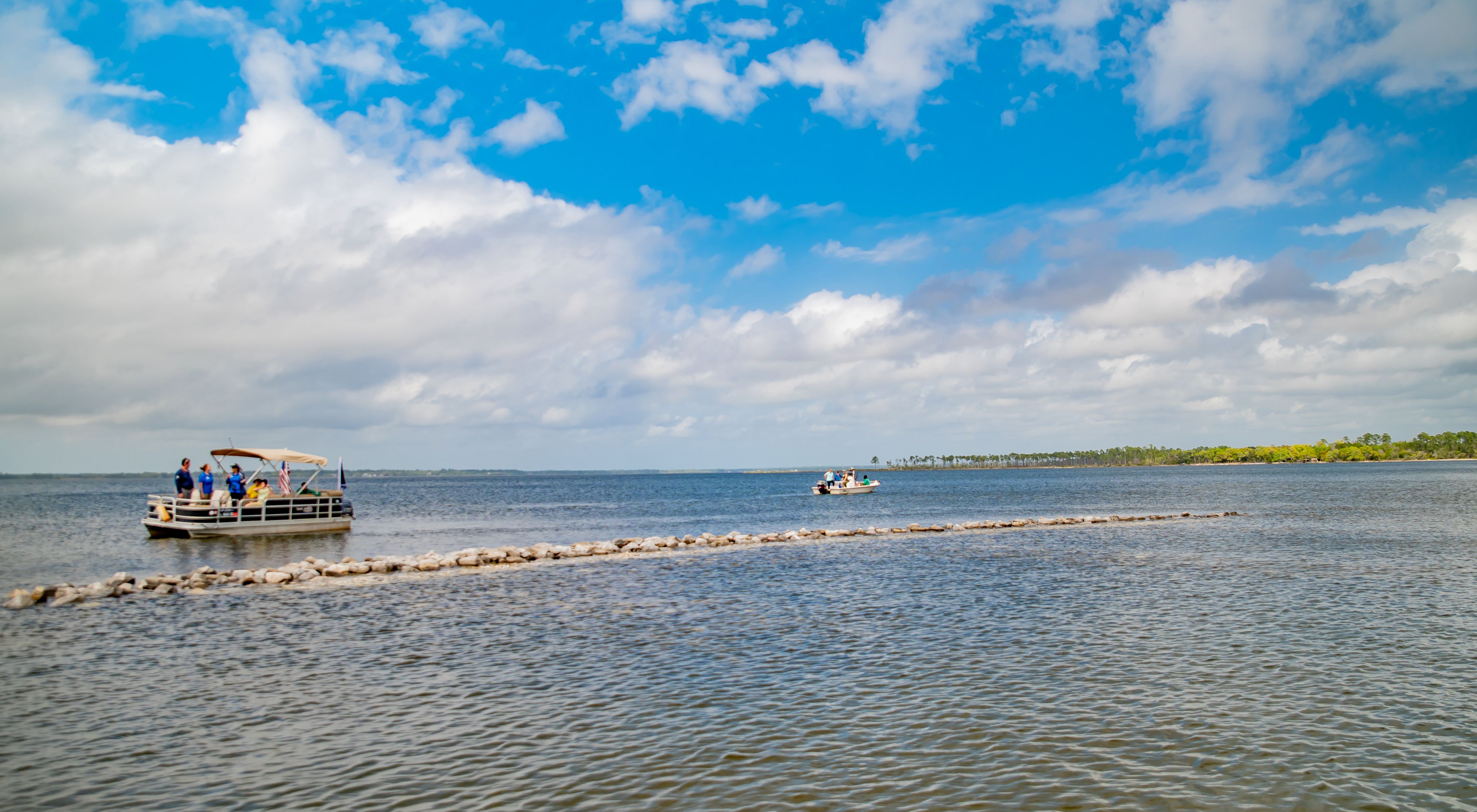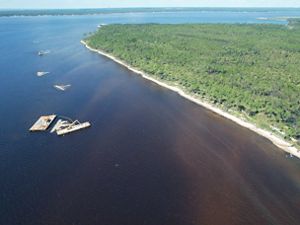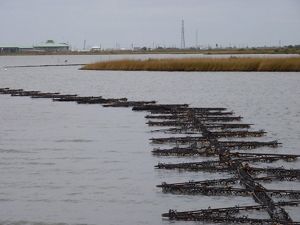TNC and Partners Celebrate Early Signs of Oyster Recovery in Pensacola’s East and Blackwater Bays
Oyster restoration efforts are underway and seeing encouraging results—and there’s more reefs being planned.
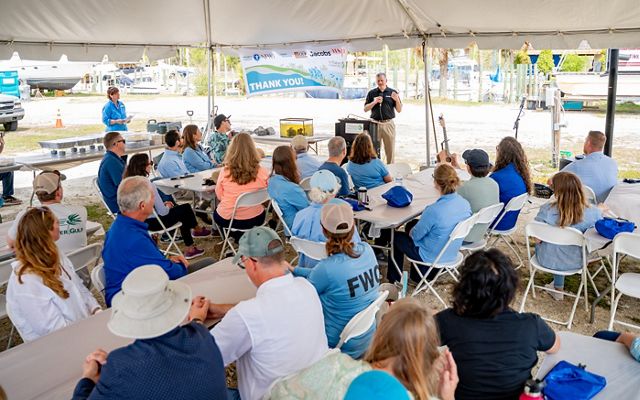
Oyster reef sees density rise.
Partners gathered to celebrate the end of construction, creating 33 new reefs that are already serving as shelter and food for oysters, fish, crabs, birds and excellent fishing spots for anglers.

The Pensacola East Bay Oyster Habitat Restoration Project aims to boost oyster populations in East and Blackwater Bays. It is the largest scale estuarine habitat restoration undertaken by TNC in Florida with reefs along 6.5 miles of Santa Rosa County shoreline, a region where oysters thrived historically but have since declined. Due to these efforts, the project received a Project Merit Award from the Climate Change Business Journal, recognizing this project for restoring oysters as an important marine habitat.
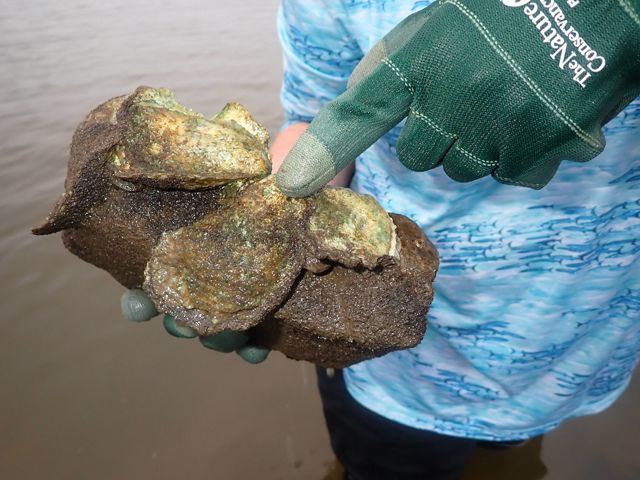
Oysters on a rock from a recent constructed reef in East Bay, Florida.
SEPTEMBER 2023 UPDATE
The oyster population in Pensacola East Bay is experiencing a remarkable resurgence. Recent monitoring in September 2023 revealed a 100% increase in oyster density compared to the previous year, a promising sign of the ecosystem’s recovery.
In September 2022, WSP, contracted by The Nature Conservancy to monitor the reefs each year conducted the first post-construction monitoring event of the newly established oyster reefs. One year later, in September 2023, the results are striking: live oyster density has doubled from 26 to 55 oysters per square meter and the proportion of live to dead oysters on the reefs has improved significantly. While these findings are encouraging, continued annual monitoring through 2026 will be essential to track the success of this oyster restoration project. The construction and monitoring is made possible with funding from the National Fish and Wildlife Foundation Gulf Environmental Benefit Fund.
AUGUST 2022 UPDATE
In August 2022, TNC and partners announced the completion of construction of the Pensacola East Bay Oyster Habitat Restoration Project, including 33 reefs, to boost oyster populations in East and Blackwater Bays. The reefs were constructed using more than 61,000 tons of limestone rock and recycled oyster shell. The first reefs were constructed in October 2021 and as of June 2022, these reefs already have oysters growing on the limestone rock! Recreational anglers are enjoying catching redfish, spotted seatrout, mangrove snapper and other fish on the reefs. Check out the animated video below illustrating reefs colonizing with oysters and attracting seagrass, fish and crabs.
July 2023 Update
An impromptu check on the reefs in July revealed that many oysters are on the reefs! It’s been one year since construction of the reefs was completed, providing the structure that was needed for oyster settlement. One of the first reefs constructed now has very big oysters—and though the reefs cannot be harvested, they are doing their job in helping to improve the depleted oyster population in the region. The reefs are also now home to blue crabs, many species of fish, and a favorite spot for shorebirds. Monitoring will continue into 2026—more good news to come!

August 2022 Update
All of the planned 33 reefs are 100% constructed using more than 61,000 tons of limestone rock and recycled oyster shell. The first reefs were constructed in October 2021. In June 2022—only 8 months later—these reefs already have oysters growing on the limestone rock! Recreational anglers are enjoying catching redfish, spotted seatrout, mangrove snapper and other fish on the reefs. Check out the animated video below illustrating reefs colonizing with oysters and attracting seagrass, fish and crabs!


August 2022 Restoration Project Update
















March 2022 Update
Ten reefs are 100% constructed using over 27,000 tons of limestone rock and recycled oyster shell, representing over 35% of total project completion. Fifteen other reefs are under construction. The 25 reefs planned for south of Escribano Point are expected to be completed in the coming months. Construction will then move to the eight reefs planned in Blackwater Bay. Construction is occurring day or night when water levels allow for barge access.


March 2022 Restoration Project Update
















December 2021 Update
Three reefs are 100% constructed using more than 3,000 tons of limestone rock and recycled oyster shell, representing 9% of total project completion. Several other reefs are under construction. Construction is occurring day or night when water levels allow for barge access. Coming soon—an animated video illustrating reefs colonizing with oysters and attracting seagrass, fish and crabs!


December 2021 Restoration Project Update
















August 2021 Update
A project more than 10 years in the making reached a key milestone on July 28, 2021, when the first limestone rocks were placed in the water. Oyster reefs provide multiple benefits to both people and nature. The rocks provide the structure needed to rebuild this critical habitat in the Pensacola Bay System.
August 2021 Restoration Project Update










About the Oyster Restoration Project
The restoration project is funded by a $13 million grant from the National Fish and Wildlife Foundation’s Gulf Environmental Benefit Fund (NFWF GEBF) through funding from the criminal settlement of the Deepwater Horizon oil spill. The reefs will help to restore oysters to the bays and in doing so benefit the oyster fishery, wildlife, water quality, and nearshore habitats. The project aligns with the new oyster fisheries and habitat management plan, created to improve the resilience and sustainability of the oysters in the Pensacola Bay ecosystem. Implementation of the oyster management plan will be led by the Pensacola and Perdido Bays Estuary Program.
Quote: Temperince Morgan

Oysters play a vital and often overlooked role in the health of our estuaries, our fisheries and our economy.
“Oysters play a vital and often overlooked role in the health of our estuaries, our fisheries and our economy. Reinvigorating and conserving the oyster population in Pensacola Bay helps restore a vital part of the region’s rich history and puts to good use funds from the Deepwater Horizon Oil Spill that impacted the region so profoundly,” said Temperince Morgan, executive director of TNC in Florida. “We’re grateful to NFWF, the State of Florida, Santa Rosa County, the community, and the many partners who have worked to make the effort to recover the oyster population here possible. Joint efforts such as this demonstrate the power of collaboration and can be replicated across the Gulf to great conservation and economic benefit.”
The oyster habitat restoration project reflects the long-term and collaborative effort of a diverse team of partners, including the oyster fishing community and a technical working group—a committee formed by TNC to provide feedback and expertise on the project design and monitoring. Participants include Eglin Air Force Base, Florida Department of Agriculture and Consumer Services Aquaculture Division, Florida Department of Environmental Protection, Florida Fish and Wildlife Conservation Commission (FWC), National Fish and Wildlife Foundation, National Oceanic and Atmospheric Administration, Santa Rosa County, Northwest Florida Water Management District, and the US Fish and Wildlife Service.
“NFWF appreciates the significant work done by The Nature Conservancy and its partners to advance the Pensacola Bay oyster restoration project to the construction phase,” said Jeff Trandahl, executive director and CEO of NFWF. “This project, like so many others in the State of Florida, is a testament to the outstanding partnerships among state and federal resource agencies, conservation organizations and local governments. These strong partnerships are the key to advancing conservation and restoration projects at a scale that will have meaningful benefits for Florida’s fish, wildlife and habitats impacted by the Deepwater Horizon oil spill.”
Quote: Anne Birch
Oysters and the reef habitat they form are vital for the health and well-being of our environment, economies, and communities throughout the Gulf of Mexico.

“Oysters are unique in the marine world in that they are a species that forms a habitat that other species rely on—and they are a fishery,” said Anne Birch, ocean and coasts strategy director for The Nature Conservancy in Florida. “Oysters and the reef habitat they form are vital for the health and well-being of our environment, economies and communities throughout the Gulf of Mexico. As one of the indicators of the health of our estuaries, a decline in oysters is a signal to us to figure out why and intervene with actions to reverse the trend. Restoration of the habitat and addressing the root causes for their decline are critical steps toward their sustainable future.”
“We are fortunate to work with The Nature Conservancy on this project,” said Chris Verlinde, UF/IFAS Sea Grant Extension Santa Rosa County. “Like oyster populations throughout the world, our local oyster populations have declined. This project will increase oyster and marine habitat in our local system and provide benefits for the local community both environmentally and economically.”
TNC lends science and conservation management expertise to the project, complemented by the efforts of coastal professionals including coastal engineering firm Jacobs, managing the design, permitting and construction; coastal construction firm CrowderGulf, installing the reefs; and professional services firm WSP, conducting science-based monitoring for the project.
The reef structures have been designed to maximize oyster settlement and success under specific local conditions, enabled by the collection and review of data reflecting over two years of pre-construction monitoring and an intensive design and engineering process. The reefs will be constructed of limestone rock of select sizes and oyster shell. They will be placed between 200-500 feet off the east shores of East and Blackwater Bays in about four feet of water and may be visible at low tides during certain times of the year.
Once completed, the reefs will offer a place for oysters to settle, grow and contribute to the ecosystem by filtering water and providing an important habitat for commercially and recreationally valuable finfish, crabs, shrimp, and birds. These reefs may also serve as a source of oyster larvae for the adjacent harvestable reefs restored by the state.
Monitoring for the project, conducted by WSP, began two years prior to construction of the oyster reefs to provide a baseline of conditions to evaluate the post-construction benefits and/or impacts of the project. Monitoring will continue for up to five years after the reefs are constructed to measure the project’s progress toward the goals of oyster recruitment to the new reefs and an increase in abundance of fish and crabs and water birds.
The following metrics are measured quarterly or annually and align with the standards developed by TNC and partners detailed in the Oyster Habitat Restoration Monitoring and Assessment Handbook (Baggett et al, 2014):
- Density of live oysters
- Oyster size frequency
- Density and size of Invertebrates
- Density of crustaceans and juvenile fish
- Density of blue crabs
- Water bird sightings
- Density and percent cover of Submerged Aquatic Vegetation
- Physical measurements: water temperature, depth, salinity, dissolved oxygen, water clarity, and wave energy

“This project will enhance the diversity of estuarine habitat adjacent to the FWC Escribano Point Wildlife Management Area, and enhance the living conditions for countless fish and wildlife species that use oyster reef systems,” said Kent Smith, Biological Administrator for the FWC’s Habitat Conservation and Restoration Section. “Collaboration between these partners has led to a large scale enhancement effort that will benefit these species and provide opportunities for the people that use and visit this system as well. The resulting oyster reef network will provide natural resilience to the effects of sea level rise, create fishing opportunities, stabilize sediments and improve water quality through the filtration provided by oysters growing on the structures. The FWC is pleased to be a partner with The Nature Conservancy on this regionally significant aquatic habitat project.”
Oyster reefs are considered one of the planet’s most imperiled marine habitats. Over the last two centuries more than 85% of the world’s oyster reefs have been lost, and this statistic is echoed in most of Florida’s bays and estuaries. Oyster reefs face a variety of threats including overharvesting, disease, pollution, and damage from boat traffic. TNC is working to restore these critical ecosystems in Florida and around the globe.
The Nature Conservancy is a global conservation organization dedicated to conserving the lands and waters on which all life depends. Guided by science, we create innovative, on-the-ground solutions to our world’s toughest challenges so that nature and people can thrive together. We are tackling climate change, conserving lands, waters and oceans at an unprecedented scale, providing food and water sustainably and helping make cities more sustainable. The Nature Conservancy is working to make a lasting difference around the world in 77 countries and territories (41 by direct conservation impact and 36 through partners) through a collaborative approach that engages local communities, governments, the private sector, and other partners. To learn more, visit nature.org or follow @nature_press on X.
